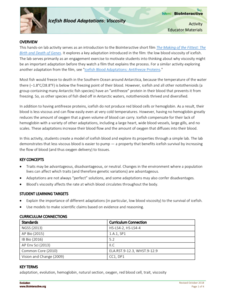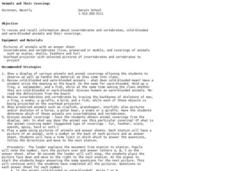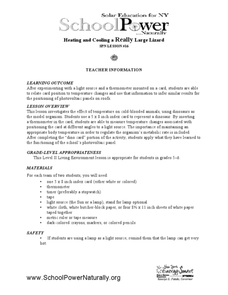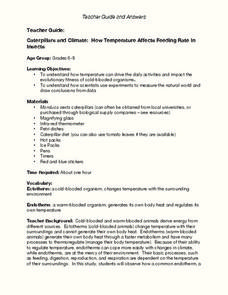Curated OER
Heating and Cooling a Really Large Lizard
Remind your middle school scientists how fox ear size varies depending on the climate they live in; large ears allow heat loss while small ears keep heat in. Discuss how a cold-blooded animal might try to regulate body temperature. Then...
Howard Hughes Medical Institute
Icefish Blood Adaptations: Viscosity
Most fish freeze to death when the water is too cold, yet some fish live in the Southern Ocean where the water is often below freezing. Scholars use two models representing the blood from most fish versus the blood from Antarctic fish....
Curated OER
Animals and Their Coverings
Students investigate the coverings of vertebrates and invertebrates and cold-blooded and warm-blooded animals. In this animals and their coverings lesson plan, students observe displays of different animals and discuss and answer...
Curated OER
Heating and Cooling a Really Large Lizard
Young scholars investigate the effect of temperature on cold-blooded animals, using a 5 x 8 inch index card to represent a dinosaur as their model organism. Students measure temperature changes that occurs at different angles to a light...
Howard Hughes Medical Institute
Icefish Blood Adaptations: Antifreeze Proteins
Ever wonder how fish survive in freezing cold water—especially Antarctic waters? Some fish have an adaptation that lowers the freezing point of their life fluids. Learners model these adaptations in two lab explorations. The first...
Smarter Balanced
Classifying Vertebrates
What features do scientists use to classify animals into groups? Class groups examine a series of paired images of vertebrates (a bass and a trout, a toad and a newt, a crocodile and a tortoise, an owl and a robin, a tiger and a bear)...
Curated OER
Cold and Warm Blooded Animals
Students research facts about a cold or warm-blooded animal in order to designa report either as PowerPoint or word processed document. They use online resources and insert images in to the report. They include the specified criteria and...
Ask A Biologist
Viral Attack
Can you catch the same cold twice? Elementary and middle schoolers learn about what happens when a virus attacks their bodies, and how the immune system never forgets a virus, with an entertaining comic book. The packet includes...
Curated OER
What's New With Dinosaurs?
Young scholars examine how scientists are at odds on whether or not dinosaurs were warm or cold blooded. In this dinosaurs lesson students divide into groups and research the evidence that supports each side.
Curated OER
Life Cycle of a Salamander
Third graders examine the life cycle of a salamander. In this life cycles lesson, 3rd graders view a PowerPoint presentation about the life cycle of a salamander. Students take the temperature of a toy salamander with a thermometer and...
Curated OER
Heat Flow
Pupils explore how a whale's countercurrent flow of blood is an example of a heat exchange system and conduction. Excellent worksheet provided.
Curated OER
Blood: Transport and Protection
In this blood worksheet, students review what makes up blood: plasma, platelets, and red and white blood cells. Students also learn how the blood helps fight viruses, bacteria, and other foreign substances. This worksheet has 10 fill in...
Curated OER
The Animal Kingdom
In this animal kingdom worksheet, students read for information and determine comprehension. In this matching and fill in the blanks worksheet, students answer twelve questions.
Howard Hughes Medical Institute
The Making of the Fittest: The Birth and Death of Genes
Adaptations must be made as environments change. This fabulous presentation features Icelandic icefish, a transparent, scaleless specimen that even has colorless blood. Genetics and adaptations concepts are explored as scientists study...
Curated OER
Caterpillars and Climate: How Temperature Affects Feeding Rate In Insects
Do you eat more when you are hot or when you are cold? Young scientists observe the eating pace of two caterpillars at different temperatures. The differences in endotherm and ecotherm animals' ability to adjust to temperature change...
Curated OER
Amphibians
Fourth graders Make flashcards for the following words, memorize them and get quizzed by the teacher: Amphibian, Lungs, complete metamorphosis, tadpoles, tail-less, tail, vertebrate, cold-blooded, gills, swamp, pond.
Curated OER
What Are Reptiles, Amphibians, And Fish?
In this animal classification worksheet, students will compare and contrast the characteristics of reptiles, amphibians, and fish. This worksheet is a graphic organizer.
Curated OER
Reptile and Amphibian Word Search
In this reptile and amphibian instructional activity, students complete a word search puzzle by finding 24 terms associated with the different types of reptiles and amphibians.
Virginia Department of Education
Heat Loss from a Fur-Insulated Animal
How do animals adapt to weather changes? Provide your class with the ability to understand adaptations and body temperature as they participate in this hands on experiment, using fake fur and hot water. Pupils collect data and analyze...
NOAA
Vertebrates II
Mammals of the ocean unite! Or not. The 20th installment of a 23-part NOAA Enrichment in Marine sciences and Oceanography (NEMO) program investigates how warm-blooded marine mammals survive in water. In the class activity, learners use...
Curated OER
Loggerhead Turtle Fun Facts
Learners study loggerhead turtles and learn facts about reptiles. In this turtles lesson, students read information about loggerhead turtles and study their various sections and characteristics. Learners then make their own sea turtle.
Curated OER
Breathing and Holding Your Breath
Five questions are presented and answered as a means of delivering information on the respiratory system. Using red and blue game chips, physiology learners model the movement of blood through the lungs. Groups of learners time how long...
Curated OER
Creatures of the Grand Canyon
For this word search puzzle worksheet, students find and circle all of the wildlife hidden in a word search puzzle. Students also classify the animals into groups of mammals, birds, fish, reptiles, or amphibians.
Curated OER
The Invisible Zoo
Pupils explore how infrared images give biologists or zoologists detailed information on how warm-blooded and cold-blooded animals thermoregulate. They are introduced to infrared imaging technology and the information that such images...
Other popular searches
- Cold Blooded Animals
- Cold Blooded Animals
- Warm Blooded Cold Blooded
- Warm and Cold Blooded Animals
- Cold Blooded Vertebrates
- Warm Blooded Cold Blooded
- Are Dinosaurs Cold Blooded
- Warm Cold Blooded
- Cold Blooded Reptiles
- Mammals and Cold Blooded
- Cold Blooded Respiration
- Warm Blooded, Cold Blooded

























